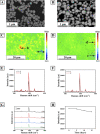Highly sensitive detection of cytochrome c in the NSCLC serum using a hydrophobic paper based-gold nanourchin substrate
- PMID: 33408980
- PMCID: PMC7747924
- DOI: 10.1364/BOE.408649
Highly sensitive detection of cytochrome c in the NSCLC serum using a hydrophobic paper based-gold nanourchin substrate
Abstract
Cytochrome c (Cyt c) is a biomarker of early apoptosis that plays a critical role in the diagnosis and therapy of non-small cell lung cancer (NSCLC). In this work, we proposed a novel surface-enhanced Raman scattering (SERS)-based biosensor to implement the ultrasensitive detection of Cyt c in the serum of NSCLC patients. The SERS-supporting substrates based on hydrophobic filter paper were composed of gold nanourchins (GNUs) surface-functionalized with the Cyt c aptamer and the cyanine 5-labeled complementary DNA. In the existence of Cyt c, it could specifically bind to its aptamer, which leads to the detachment of complementary strands modified with Cy5 and the great weakness of SERS signal. The finite-difference time domain (FDTD) simulation showed that the excellent SERS performance of GNUs aggregation was strongly dependent on a large number of "hot spots" at the tips and between the nanogaps of aggregated GNUs. Alkyl ketene dimer (AKD) was used to make the filter paper modify its property from hydrophilic to hydrophobic, which consequently increased the density of GNUs and extended the retention time of the analyte. SERS biosensors based on hydrophobic paper exhibited prominent reproducibility and selectivity. The detection limit of Cyt c in PBS was 1.148 pg/mL, while the detection limit in human serum was 1.79 pg/mL. Moreover, the analysis of the serum samples of healthy subjects and NSCLC patients confirmed the feasibility of its clinical application. The results were consistent with enzyme-linked immunosorbent assay results. This method can be a powerful strategy for quantitative detection of extracellular Cyt c, and it is expected that the SERS-based biosensors could be applied in the practical clinical diagnoses of NSCLC.
© 2020 Optical Society of America under the terms of the OSA Open Access Publishing Agreement.
Conflict of interest statement
The authors declare that there are no conflicts of interest related to this article.
Figures








Similar articles
-
Subnanomolar Sensitivity of Filter Paper-Based SERS Sensor for Pesticide Detection by Hydrophobicity Change of Paper Surface.ACS Sens. 2018 Jan 26;3(1):151-159. doi: 10.1021/acssensors.7b00782. Epub 2018 Jan 12. ACS Sens. 2018. PMID: 29282983
-
Surface-Enhanced Raman Scattering-Fluorescence Dual-Mode Nanosensors for Quantitative Detection of Cytochrome c in Living Cells.Anal Chem. 2019 May 21;91(10):6600-6607. doi: 10.1021/acs.analchem.9b00480. Epub 2019 May 7. Anal Chem. 2019. PMID: 31026147
-
A disposable paper-based hydrophobic substrate for highly sensitive surface-enhanced Raman scattering detection.Talanta. 2020 Dec 1;220:121340. doi: 10.1016/j.talanta.2020.121340. Epub 2020 Jul 12. Talanta. 2020. PMID: 32928387
-
Development and evaluation of a gold nanourchin (GNU)-based sandwich architecture for SERS immunosensing in liquid.Spectrochim Acta A Mol Biomol Spectrosc. 2022 May 15;273:121069. doi: 10.1016/j.saa.2022.121069. Epub 2022 Feb 21. Spectrochim Acta A Mol Biomol Spectrosc. 2022. PMID: 35231760
-
Dual platform based sandwich assay surface-enhanced Raman scattering DNA biosensor for the sensitive detection of food adulteration.Analyst. 2020 Feb 17;145(4):1414-1426. doi: 10.1039/c9an02106j. Analyst. 2020. PMID: 31845928
Cited by
-
Biorecognition Engineering Technologies for Cancer Diagnosis: A Systematic Literature Review of Non-Conventional and Plausible Sensor Development Methods.Cancers (Basel). 2022 Apr 7;14(8):1867. doi: 10.3390/cancers14081867. Cancers (Basel). 2022. PMID: 35454775 Free PMC article. Review.
-
Cytochrome c in cancer therapy and prognosis.Biosci Rep. 2022 Dec 22;42(12):BSR20222171. doi: 10.1042/BSR20222171. Biosci Rep. 2022. PMID: 36479932 Free PMC article.
-
Template-Free Synthesized Gold Nanobowls Composed with Graphene Oxide for Ultrasensitive SERS Platforms.J Phys Chem C Nanomater Interfaces. 2023 Aug 18;127(34):16960-16969. doi: 10.1021/acs.jpcc.3c03607. eCollection 2023 Aug 31. J Phys Chem C Nanomater Interfaces. 2023. PMID: 37674654 Free PMC article.
-
Analysis of the Interaction between DNA Aptamers and Cytochrome C on the Surface of Lipid Films and on the MUA Monolayer: A QCM-D Study.Biosensors (Basel). 2023 Feb 9;13(2):251. doi: 10.3390/bios13020251. Biosensors (Basel). 2023. PMID: 36832017 Free PMC article.
-
A simple and efficient strategy for trace detection of ferroptosis-related miRNAs based on novel hydrophobic paper-based plasmonic substrate and "inverse molecular sentinel (iMS)" nanoprobes.Front Bioeng Biotechnol. 2023 Mar 2;11:1146111. doi: 10.3389/fbioe.2023.1146111. eCollection 2023. Front Bioeng Biotechnol. 2023. PMID: 36937763 Free PMC article.
References
-
- Asamura H., Goya T., Koshiishi Y., Sohara Y., Eguchi K., Mori K., Nakanishi Y., Tsuchiya R., Shimokata K., Inoue H., Nitkiwa T., Miyaoka E., “A Japanese lung cancer registry study-Prognosis of 13,010 resected lung cancers,” J. Thorac. Oncol. 3(1), 46–52 (2008).10.1097/JTO.0b013e31815e8577 - DOI - PubMed
LinkOut - more resources
Full Text Sources
Miscellaneous
